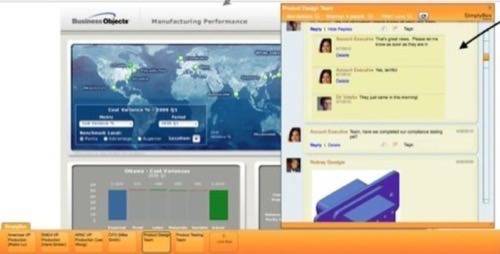Well, almost any browser based app anyway. Socialcast announced today a new product called Socialcast Reach. Reach will bring Socialcast streams into SharePoint or any other application that supports HTML and JavaScript. Socialcast is trying to solve the problem of too many applications by bringing activity streams into the applications users already spend their time in.

Socialcast’s approach is similar to but different from the approach taken by SimplyBox. SimplyBox has created a collaboration tool that can run as a web application, desktop application, Outlook plugin and browser plugin. The browser plugin allows users to access their SimplyBox streams from any web based application.
Silo Smasher
Activity streams have the potential to achieve the holy grail of enterprise 2.0 technology: enabling collaboration across silos. But there’s a problem: users have enough different applications to use on a daily basis without adding one more for place to look for and make updates.
“One of the fundamental barriers to a collaborative enterprise are the systems themselves,” IDC analyst Michael Fauscette wrote recently. “Software is often created, packaged and sold in silos and integration is hard.”
Socialcast and SimplyBox attempt to solve that problem by enabling users to put activity streams wherever they want without difficult or expensive integration work.
Socialcast Reach users will be able to create snippets of code to insert into the applications they want to use Socialcast with. SimplyBox provides a plugin that overlays the SimplyBox interface on top of other applications. Here’s a screenshot of it being used with SAP‘s Business Objects:

The video below explains a bit more about how SimplyBox works:
Altimeter Group‘s R “Ray” Wang praised SimplyBox and called it a disruptive technology earlier this year. “Expect to see SimplyBox transforming experiences in staid ERP, CRM, and SCM systems,” he wrote.
IT consultant Larry Blair told me he choose SimplyBox over Salesforce.com‘s Chatter because it would reduce the number of different places his teams would have to look for information, and because it was easy to collaborate with customers and other outside users.
Stream Standards
SimplyBox’s solution is quite elegant, and I’m sure Socialcast Reach will be as well. However, one can’t escape the notion that these solutions are just being bolted onto other software that isn’t designed for social interaction. To combat this, SimplyBox is partnering with SAP to create native SimplyBox support in some applications. SimplyBox already works within SAP CRM, for example.
However, enterprise software built to from the ground up to be social would be much better. Sameer Patel wrote:
What we haven’t really seen is back to the drawing board innovation on business process design. Over the last decade we’ve mistakenly begun to believe that the best way to execute a given business activity is synonymous with how our ERP systems enforced our way of work. Ever since the wide scale adoption of ERP applications, largely thanks to the Y2K hoax, we’ve been judiciously streamlining process in black and white. Ensuring that every application has a Submit and a Cancel Button. Commit your decision now, or roll back. Choose now and forever hold your peace.
Decisions are not always black and white in the Enterprise context. To me, the ultimate promise of social computing lies in improved process execution outcomes. What I’ve been looking for is an in-context and even onscreen utility inside enterprise process apps that helps you answer: “I’m not sure” OR “What’s the best selection from that dropdown menu” OR “Who knows more about this than I?” OR “Can I first take a vote from a few smarty pants before I commit, please?
Open standards for activity streams and social data will be crucial to this process of re-invention. Socialcast currently support the ActivityStreams format and Reach will support Facebook‘s Open Graph Protocol, so it will be well positioned for the future integration with social enterprise applications.










